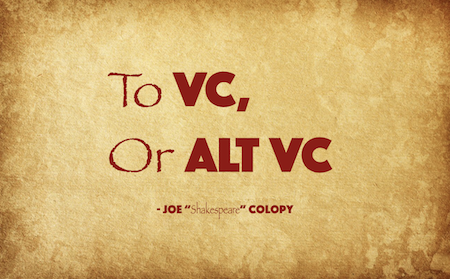TO VC, OR ALT VC?
Modern day Shakespeare would be a startup entrepreneur asking the question: “TO VC, or ALT VC?” Raise venture capital or bootstrap? Bootstrapping is a hard but great alternative to raising venture capital (VC).
Unfortunately, the media rarely tells the story of the bootstrapping startup. The more commonly told story is of the glories of raising VC. Raising VC makes for a great story but the consequences of those choices, if not thought through, can have very not exciting and sometimes painful consequences for the entrepreneur a few years down the road.
Because of hype around funding, many entrepreneurs confuse the formula for startup success as one of raising capital versus one of getting customers and generating revenue. This is akin to highlighting that you are going to run a marathon versus actually running one. The emphasis is erroneously placed on the intent versus the result.
My last company, Bronto, was entirely bootstrapped — no venture capital, no angel investment, no private equity, no subsidizes from existing businesses, etc. But, despite that, Bronto required a huge investment — an investment in time and forgone salary. In the summer of 2000, I left my mid-level marketing position at Red Hat and the last paycheck that I would see for three years. It was a hard road to travel but I had several advantages that prepared me well for the journey:
- Savings. Karalyn are I are savers. We geared up to live our life on one salary (hers!) for a long time. We kept our “burn rate” low and planned for the long game.
- Habit. I used to be a Peace Corps Volunteer and made $6k/year (outside of housing.) So, I was used to living with little.
- Cheap. I can be scrappy. I taught myself web programming (LAMP = Linux Apache MySQL PHP/Perl) so I could be self sufficient and create my own product. I didn’t want to become a developer but had to learn these new skills in order to create the product and start the company. Hiring developers was an expensive option that I wasn’t able to afford.
On the flip side, I was fortunate because I didn’t have other challenges like heavy student debt (I paid it off beforehand), struggling or dependent family members (parents and siblings stable, no kids yet), and other things that would have made these choices very difficult. Also, many software companies are not capital intensive businesses to start. Biotech or manufacturing stories would be very different.
Bootstrapping is more common in tech than one might think. Here are a few examples:
- SAS. Cary NC-based analytics company, generating over $3 billion in revenue per year. A forty-year overnight success story!
- MailChimp. Atlanta-based email marketing powerhouse, doing over $400 million in revenue.
- Zoho. India-based cloud business app provider, generating over $400 million in revenue.
We all started and grew in highly competitive spaces. We all thrived because we could exclusively focus on the customer with a long-term perspective.
Why don’t all startups bootstrap? Well, it’s hard. Money helps. And, often the entrepreneur’s life situation prevents them from doing so. Also, many believe that there is a race to market and the window will close. This can be true but I believe that is usually not the case if the entrepreneur aims to build along-term sustainable organization versus a short-term M&A transaction. Other times, the startup truly has a unique business model that needs to be funded differently. Great VC success stories are often like this — Red Hat, Google, … And, sometimes the models don’t always work, like Napster, but still made sense to be VC funded.
Some will say that “the VC model is broken.” This is partially because the model is applied to too many tech startups where the economics won’t work, especially for the entrepreneur. Most tech startups and their entrepreneurs would be better served by bootstrapping. Plus, it has many advantages, like:
- Financial. Bigger piece of a small pie often makes more financial sense. And, sometimes those pies aren’t so small. Of VC-backed startups, founders collectively own 15% of the company at the time of IPO. That percentage is much higher for bootstrapped founders. Plus, there isn’t the same pressure to have an IPO for institutional investor liquidity and these founders avoid the hard reality of liquidation preferences when early lofty valuations don’t match acquisition prices. (More here! This could be an entirely different post.)
- Focus. Investors can bring many benefits beyond money. But, they also require time and focus — at the expense of your customers and employees.
- Direction. What do you want to do? Do you want to be high profile and grow faster or would you have more control to shape the destiny of your creation? Either way is fine. Just make the choice deliberately because your financing choice will dictate your path. And, if that direction is inconsistent with your vision, you will lose.
VC can make sense. But, it is not the only game in town. Its important to do what makes sense for your business and, most importantly, for you. Also, the required discipline around bootstrapping makes for great businesses. And, great businesses attract incredible employees, customers and even investors. They all want the same thing.
In the end, VC or ALT VC depends on what you want to do. Both paths can lead to great businesses but can have very different outcomes for the entrepreneur.
To VC, or ALT VC? This is the question. Easy to ask. Hard to answer.

